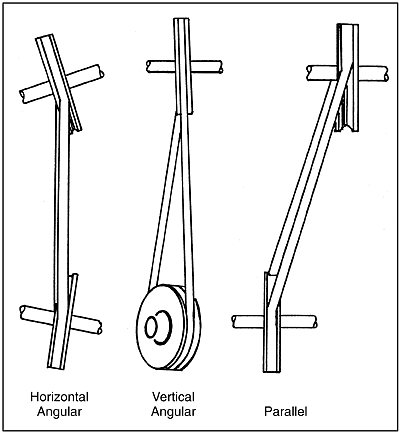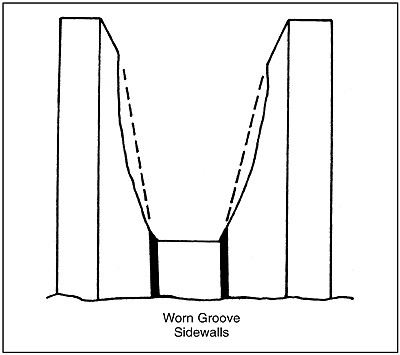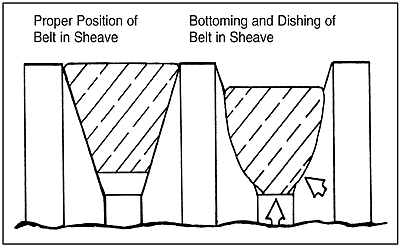Some companies haven’t readjusted their v-belts for ten years, while others have continual problems. It’s possible some of these problems are due to people believing they have properly aligned v-belts when they actually do not.
This article will not address v-belt installation; manufacturers’ manuals do a great job of covering that topic. The following will discuss belt, sheave, and bushing wear. From abnormal wear, we can learn what needs maintenance. The goal is to reduce warranty situations, while providing better operating equipment.

Preventive Belt Maintenance
During compressor downtime, inspect drive parts. Look at the flywheel, sheave, bushing, and belts. Do you see unusual wear? First, let’s focus on belts.Some v-belts have a protective coating, or wrap, over the raw belt material. Over the years, there have been numerous instances where companies spend big bucks on top- quality belts, only to find they lasted from as little as three hours to a couple of weeks. Why?
They bought top-of-the-line, raw, uncoated, and sometimes cogged v-belts. While the gripping power of these belts outperform coated belts in most other applications, reciprocal compressor units that load and unload are unique. We actually want belts to slip!
Belt slippage is inefficient, and normally undesirable, but it is helpful in these applications. Loading and unloading of compressors sends pulses through drive systems. This causes the v-belts to stop briefly. Coated belts are designed to slip just enough to emit occasional squeaks, while dampening some of the vibration. This is very much like how drag-race cars spin their tires at the start of a race. If belts grabbed so much that they wouldn’t briefly slip, they’d turn over, hop out of their grooves, tear their inner fibers, or break at every startup.
A lot can be learned by studying v-belt surfaces. Are they cracked, broken, or worn? Over a period of time, wearing normally occurs. It is unnatural wear that we seek.
Ruptured covers come from installers who think they are prying on bicycle or motorcycle innertubes instead of fiber-filled, high-tech coated v-belts. Using screwdrivers or pry bars to cram v-belts over flywheels and sheaves causes tears in the bottoms of the belts, and it rips vital inner fibers that keep the belts from stretching. Belts almost immediately turn over or break during run-in. This development gives the impression that the belts are no good, and some will want banded belts because single belts flip over. In reality, the problem was due to faulty installation technique, not faulty belts. Users need education, so both they and the manufacturer are best served. Following the proper installation procedures shown in installation bulletins should avoid such a trap.
Should the covering be worn on the backsides or wider top sides of the v-belts, customers are enduring noisy drives. V-belts are slapping against the inside top of their belt guards. Belt slack should be on the bottom of the drives. In this instance, slack is on the top, and this leads to the previously mentioned wear condition. Fiber can tear, and belts can jump out of their grooves, or roll over. New belts should be properly tightened.
If slack is both on the top and bottom of the belts, only a few of the belts take up the brunt of the starting torque, and belts can break due to exceeding their horsepower-per-belt ratio.
Sidewall wear is definitely an indicator of misalignment. It leads to belts rolling over, slipping, or hopping out of grooves. No one wants this nuisance problem, so proper alignment and new belts are the answers.
Misalignment Mishaps
There are three types of misalignment, as illustrated in Figure 1. They are horizontal angular (pigeon-toed), vertical angular (angle or cocked), and parallel (off-set).Horizontal angular misalignment has either the driver or the driven pulley twisted out of alignment with the other pulley. For example, if a motor shaft is not parallel with the compressor shaft, the drive is out of alignment. Sidewall wear is visible, and again, both roll over and groove-hopping is likely.
Vertical angular misalignment has either the driver or the driven pulley twisted out of alignment with the other pulley. For example, if a motor leans inward, the drive sheave, or pulley, is tilted out of alignment with the flywheel, or driven pulley. Sidewall wear would occur, both would roll over and/or hop their grooves, etc. Once again, users may experience this and believe that banded belts are the answer. They are not. Their use in this application may temporarily mask misalignment, but proper alignment is the remedy. Parallel misalignment has belts misaligned by not having the driver or the driven pulley grooves in a straight line with each other and the v-belts. By using a string and running it from the far side of a drive groove to the opposite end of a matching driven pulley groove and along a v-belt connecting the groove, installers easily see gaps indicating misalignment.
When used to address misalignment, banded belts often develop torn areas between belts. This, too, indicates misalignment. It is caused by unwanted flexing during normal running time, especially during loading and unloading. This happens during all three kinds of misalignment listed above.

The Many Faces Of Wear
Banded belts receive cut tie bands when sheaves or flywheels are deeply worn. At first, this looks like misalignment, but it isn’t. Installers check misalignment, but find the unit is aligned. They next might look for sheave or flywheel wear or damage. Finding a shiny metal surface indicates excessive wear, and the worn pulley and banded belt(s) are replaced.Spin burn is another wear condition. It looks similar to a ruptured cover, except surfaces are smoother, shinier, and glazed. Improper tension is the most common cause. Re-tension the belts, if they are still in usable condition. If belts have been overtensioned, they’ll slip because internal fibers are broken. This makes belts like ever-stretching rubber bands, and they will not properly grip around sheaves and flywheels. They may also hop out of their grooves or roll over. They’ll also have increased slack that could cause the fabric to wear on the backside due to rubbing against the inside of the belt guard, and vibration will increase.
Vibration is possible with all forms of misalignment. Although some vibration is normal with reciprocal compressors, as it is in car, truck, or motorcycle engines, excessive vibration is a “flag” indicating possible drive belt misalignment.
Since belts in this article are designed to operate with a slight bit of slippage during startup, loading, and unloading, belt dressings or other abrasives should not be used. Dust, sand, and grit cause excessive wear to the sides of v-belts, via a “sandpaper effect.” Abrasive wear from any foreign objects should be avoided.

Too Much Heat
Heat cracks are caused by drives that are running too hot. Slippage sometimes occurs, due to glazing. This appears as wear and cracks on the bottom of v-belts. Install new belts and make sure the area is well-ventilated to cool the new belts. Overtensioned belts can run hot, and cause overheated motor bearings, bent shafts, and excessive tension, as well as possibly causing the belts to break.Oil and grease, obviously, cause slippage and should be kept off belts and machine pulley drive surfaces. Use detergent and water to clean the belts and pulley grooves. Keep water and other liquids from splashing onto belts and pulleys.
If The Problem Persists
Next, let’s look at problems with sheaves, flywheels, or bushings. Often, even though it seems as if everything has been done and re-done properly, some little but important item has been overlooked. Much of the damage done to v-belts is caused by something being wrong with a pulley or a bushing.Flywheels are driven pulleys, and sheaves are driver pulleys. Normal wear can cause v-belt damage. After a long period of operation, in some cases many years, grooves deepen in sheaves and flywheels. New single belts will fit beneath the top of the grooves. This changes the operating speed, and it increases belt slippage. Belt manufacturers offer inexpensive plastic sheave templates for measuring pulley grooves. Hold a lit flashlight behind the template, and look for light passing between the template and the groove; light indicates wear.
Check sheaves and flywheels for rust and foreign material, such as paint. Use a wire brush and a shop cloth to clean the pulley. For dents, carefully use a file to blend the area with the rest of the groove surface. As mentioned, oil and grease should not be present on pulleys. Remove lubricants with detergents and water.
Avoiding Rapid Belt Wear
Worn sidewalls on pulleys cause rapid belt wear (Figure 2). Belts bottom out, and smooth, polished groove surfaces increase belt slippage. Vibration rises. Maintenance personnel notice belt slippage, and they may sometimes believe this is due to loose belts. As a result, this is often where over-tensioning subsequently occurs: belts are tightened, and internal fibers break. Belts are tightened again, and maybe again. It’s decided the belts are no good, when the worn sheave is the actual culprit. Side and bottom wear on v-belts indicates pulley groove wear. Change the pulley. Normally, longer v-belt life pays for itself in reduced downtime and maintenance.When bottoms of pulley grooves are shiny (Figure 3), belts have buffed the surfaces smooth. Replace the sheave or flywheel, because efficiencies have dropped. Belt slippage has increased. The unit no longer produces the amount of work is was designed to do. Replace worn belts, too!
Wobbling sheaves are caused by both worn or cracked bushings, and/or by bent motor shafts. Replace the bushing, or have the motor repaired. Vibration rises under this condition. Belts are not smoothly entering pulley grooves, and an eccentric weight is gyrating on the driver side of the system. Check the sheave for uneven groove wear.
Damaged sheaves are another cause of belt drive headaches. A forklift truck might have backed into a compressor drive and chipped part of a sheave. This ruins the sheave, and a multitude of problems can occur. Vibration increases, and a notch in a pulley could thrust a belt out of a groove or, at least, overturn the belt. Replace the pulley, if it can’t be repaired, and inspect the v-belts for damage.
When excessive slippage is present, heat is generated. Belts don’t always squeal when slipping. To find out if slipping is happening, cautiously slide your index finger along the inside of a pulley groove of a just-stopped unit. If belts are slipping, you’ll quickly notice the heat.
Belt Position
Properly turning belt drives are quiet. Belts help absorb unit vibration, and a slight “bow” should appear in all of the belts on the bottom of the drive.In my experience, users often think they should use 10-belts because their flywheel has 10-grooves. This is not the way belts are chosen. Belts are selected by a hp/belt ratio combined with the belt wrap surface area on the pulleys. While adding additional belts increases belt life, it also increases the changes of overheated bearings and bent shafts.
V-belts should be on the inside grooves closest to the motor, and mount the sheave as near to the motor as is possible to help eliminate shaft bending and bearing wear.
When installing bushings and sheaves, do not lubricate the mating surfaces. This gives an inaccurate torque wrench reading, and it leads to cracked bushings. Sheave wobbling is often traced to cracked bushings, leading to worse, more expensive problems. Unequal or excessive pressure on bushing jack screws can break the bushing flange. Removal becomes nearly impossible without damaging the more costly sheave. Properly mounted, aligned, and maintained sheaves, bushings, and flywheels will last for many years. A little bit of extra care eliminates excess wear and protects an efficient drive system. ES
